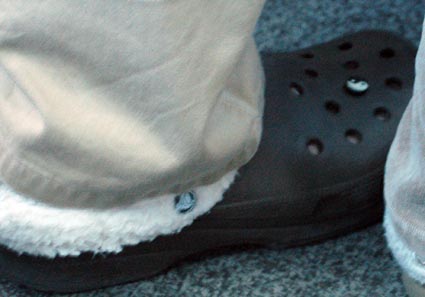I’m amazed (constantly) at how fast this blogosphere stuff is. BoingBoing posts a story about a stupid move by a corporation or politician, and within 24 hours there are t-shirts, slogans, dance videos on YouTube, mashups with new lyrics; all based on some simple and outrageous idea.
I was actually refreshed (instead of my usual infuriated) when a story about running into (a lookalike for) Samuel Jackson at the airport did not turn into a Snakes On Plane (or SoaP as it’s now known) story. Further, one of the people in the group hadn’t heard of the movie (et. al).
And no, I’m not going to explain any of that, or even provide links. That’s sort of my point – that a seemingly tight network establish common language and points of reference proceeds to further riff as any group does) in extremely inventive and entertaining ways. But it’s very disposable. You don’t need to know why my Rolling Stones group makes jokes about cheese, and you don’t need to know why Samuel Jackson wants to get the motherfucking snakes off the motherfucking plane. If you do want to know, there’s always Google.
But my impetus for this post (finally!) was this (via Chroma with absolutely no context provided): an instantly famous sports moment (a head-butt in a World Cup match) is now rendered as an 8-bit Nintendo game, complete with animation and sound effects and music.
Sure, it was the World Cup, and it was one of the more dramatic moments (I guess; I didn’t see moment one of the whole affair), but isn’t interesting how some people – many people – don’t know of the original moment, but others are doing their own versions of it? Indeed, maybe someone reading this will learn about the head-butt (and I’m not going to bother looking up the story, who it was, that’s my point, the partial knowledge or even lack of knowledge, in the face of all this other energy – maybe Ronaldo or Ronaldino or Rodolfo – either you know how wrong I am, or you have no idea what I’m talking about) as a second-order effect.
The classic example of this is kids using Mad Magazine as a source for plot lines and famous moments of classic films. I read many issues of Mad, long before I saw a James Bond film or Chinatown, yet I was conversant with their iconic aspects through exposure to the parody.
Update: moments after posting this I see (via Experience Curve, also without explanation) another funny site on the same incident – here – and learned that the player’s name is (presumably) Zidane. No Ronaldino, guess I was wrong. And I noticed that both these paraodies came from the same domain. Whoah! It’s called YTMND – You’re The Man Now Dog, and they’ve got a great story.
YTMND is a site created for the purpose of furthering the creativity of its users. It stems from an idea that, using sound, and image, and some text, the users can convey a point, funny, political, or otherwise, to the general media.
I know someone is reading this and thinking “Dude, you don’t know about YTMND?!”





